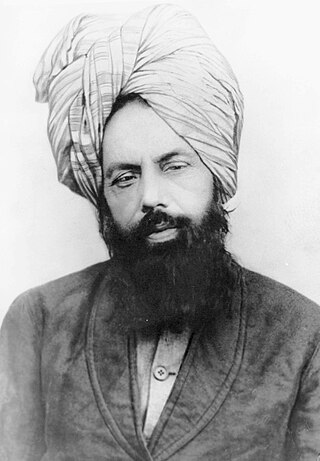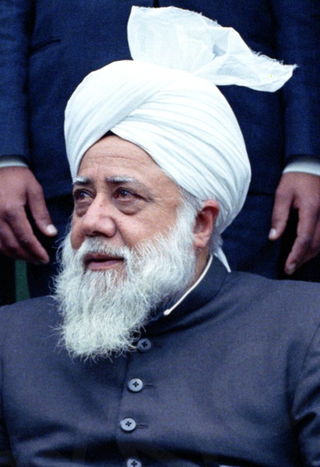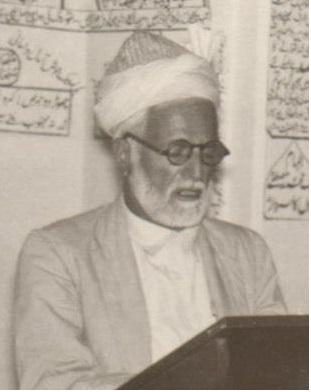Rabwah, officially known as Chenab Nagar, is a city in Chiniot, Punjab, Pakistan on the bank of Chenab River. It was the headquarters of the Ahmadiyya Muslim Community from September 20, 1948 when the community relocated from Qadian, India to the newly created state of Pakistan, where the Community leased the area of present-day Rabwah from the government to establish its home. This continued until 1984 and the establishment of Ordinance XX. In 1984, the headquarters were moved to the United Kingdom with Mirza Tahir Ahmed, first to London and then in 2019 to the Islamabad compound in Tilford, Surrey.

MirzāGhulām Aḥmad was an Indian religious leader and the founder of the Ahmadiyya movement in Islam. He claimed to have been divinely appointed as the promised Messiah and Mahdī—which is the metaphorical second-coming of Jesus (mathīl-iʿIsā), in fulfillment of the Islamic prophecies regarding the end times, as well as the Mujaddid of the 14th Islamic century.

The Ahmadiyya Caliphate is a non-political caliphate established on May 27, 1908 following the death of Mirza Ghulam Ahmad, the founder of the Ahmadiyya Muslim Community, who claimed to be the promised Messiah and Mahdi, the expected redeemer awaited by Muslims. It is believed by Ahmadis to be the re-establishment of the Rashidun Caliphate that commenced following the death of the Islamic prophet Muhammad. The caliphs are entitled Khalīfatul Masīh, sometimes simply referred to as Khalifa. The caliph is the elected spiritual and organizational leader of the worldwide Ahmadiyya Muslim Community and is the successor of Ghulam Ahmad. He is believed by the Community to be divinely ordained and is also referred to by its members as Amir al-Mu'minin and Imam Jama'at. The 5th and current Caliph of the Messiah of the Ahmadiyya Community is Mirza Masroor Ahmad.

Mirza Tahir Ahmad was the fourth caliph of the worldwide Ahmadiyya Muslim Community. He was elected as the fourth successor of the founder of the community, Mirza Ghulam Ahmad. He was elected on 10 June 1982, the day after the death of his predecessor, Mirza Nasir Ahmad.

Mirza Nasir Ahmad was the third Caliph of the Ahmadiyya Muslim Community. He was elected as the third successor of Mirza Ghulam Ahmad on 8 November 1965, the day after the death of his predecessor and father, Mirza Basheer-ud-Din Mahmood Ahmad.

Mirza Basheer-ud-Din Mahmood Ahmad was the second caliph, leader of the worldwide Ahmadiyya Muslim Community and the eldest son of Mirza Ghulam Ahmad from his second wife, Nusrat Jahan Begum. He was elected as the second successor of Mirza Ghulam Ahmad on 14 March 1914 at the age of 25, the day after the death of his predecessor Hakim Nur-ud-Din.

The Fazl Mosque also known as The London Mosque, is the first purpose-built mosque in London, England. It was opened on 23 October 1926 in Southfields, Wandsworth. At a cost of £6,223, the construction of the mosque and the purchase of the land on which it stands, was financed by the donations of Ahmadi Muslim women in Qadian, Punjab, British India, with support from the British Muslim convert Khalid Sheldrake. Between 1984 and 2019 the Fazl Mosque was the residence of the caliphs of the Ahmadiyya Muslim Community, and therefore its de facto international headquarters. The administrative headquarters now lies at the site of the Islamabad, Tilford.

Mirza Masroor Ahmad is the current and fifth leader of the Ahmadiyya Muslim Community. His official title within the movement is Fifth Caliph of the Messiah. He was elected on 22 April 2003, three days after the death of his predecessor Mirza Tahir Ahmad.

Bai'at or Bay'ah is an Islamic practice of declaring on oath, one's allegiance to a particular leader. In an Islamic religious context, this oath is the standard procedure of pledging allegiance to a religious leader. It is known to have been practiced by the Islamic prophet Muhammad and his successors (caliphs) after him with those wishing to join the Islamic community. Within the Sufi tradition the term is used to refer to the process of initiation into a Sufi order with the idea of commending oneself to a spiritual master in exchange for the spiritual and moral guidance imparted by him. The Bay'ah is a practice that also forms a notable feature within Ahmadiyya Islam. Following the death of a Caliph, the leader of the Community, a pledge of allegiance is taken by the newly chosen Caliph from members of the Community based upon this prophetic model and the bay'ah is the standard procedure for formally joining the Ahmadiyya Muslim Community.

The Baitul Huda Mosque is a mosque located in the Sydney suburb of Marsden Park, in New South Wales, Australia. The mosque is run by the Ahmadiyya Muslim Community (AMC).

Ahmadiyya, officially the Ahmadiyya Muslim Community or the Ahmadiyya Muslim Jama'at, is an Islamic revival or messianic movement originating in British India in the late 19th century. It was founded by Mirza Ghulam Ahmad (1835–1908), who claimed to have been divinely appointed as both the Promised Mahdi and Messiah expected by Muslims to appear towards the end times and bring about, by peaceful means, the final triumph of Islam; as well as to embody, in this capacity, the expected eschatological figure of other major religious traditions. Adherents of the Ahmadiyya—a term adopted expressly in reference to Muhammad's alternative name Aḥmad—are known as Ahmadi Muslims or simply Ahmadis.

The Lahore riots of 1953 were a series of violent riots against the Ahmadiyya Movement, a faith marginalized in Pakistan, mainly in the city of Lahore, as well as the rest of Punjab, which were eventually quelled by the Pakistan Army who declared three months of martial law. The demonstrations began in February 1953, soon escalating into citywide incidents, including looting, arson and the murder of somewhere between 200 and 2000 people. Thousands more were left displaced. According to the official inquiry conducted by the Punjab Government, the actual number killed in these riots was around 20. The first page of the inquiry says that before the declaration of martial law, the police killed two people on the night of 4th March and ten the 5th. 66 people were admitted to Lahore hospitals with gunshot wounds. The military attempting to quell the disturbances in Lahore admitted to killing 11 and wounding 49. There were additional casualties in other towns. Seeing that police were unable to contain the increasingly widespread unrest, Governor-General Malik Ghulam Muhammad handed over the administration of the city to the army under Lieutenant General Azam Khan, imposing martial law on 6 March.

Jalsa Salana is a formal, annual gathering of the Ahmadiyya Muslim Community. It was initiated in 1891 by Mirza Ghulam Ahmad, the founder of the community, in Qadian, India. Usually, the gathering spans three days, beginning with the flag hoisting ceremony following the Friday Sermon. Although the convention held in the UK is deemed to be the major and 'international Jalsa' attended by Ahmadis from across the world, Ahmadis in other countries hold their own national Jalsas, sometimes attended by the Khalifatul Masih.

Majlis Khuddam-ul-Ahmadiyya is one of five auxiliary organizations in the Ahmadiyya Muslim community. It is the young men's branch of the community, particularly for those between the ages of 15 and 40. In some English-speaking countries it is also known as the Ahmadiyya Muslim Youth Association (AMYA).
Bahishti Maqbara, located originally in Qadian, India, and then in Rabwah, Pakistan, is a religious cemetery established by the Ahmadiyya Community as a directive from the community's founder Mirza Ghulam Ahmad, made known in his booklet Al-Wasiyyat. Mirza Ghulam Ahmad established it in his will after he saw an angel showing him the place of his burial.
The word Mirzai is a religious slur used to refer to Ahmadis by many South Asian Muslims, primarily in Pakistan where they have been persecuted from early days and specially after the passage of Second Amendment to the Constitution of Pakistan which declares that Ahmadia are not Muslims and Ordinance XX. Ahmadis are the followers of Mirza Ghulam Ahmad of Qadian.

Shams ud Din Khan (1900–1969) was a notable early Pashtun Ahmadi in the North West Frontier province of India. He remained its Provincial Ameer [Head] (1969). He was a close associate of Khalifatul Masih II and III.( Mirza Basheer-ud-Din Mahmood Ahmad and Mirza Nasir Ahmad) in his lifetime. He was a member of the Jama’at Khilafat Committee [Electoral College] and was one of the two proposers of the name of Mirza Nasir Ahmad at the time of his Election to the seat of Khilafat in November 1965. He remained a member of the Majlis Shura [Consultative Assembly] of the Ahmadiyya Muslim Community in Pakistan.

Ahmadiyya is an Islamic movement in Australia, first formally founded in the country in the 1980s, during the era of the fourth caliph. However, the history of the Community dates back to the early 20th century, during the lifetime of the founder of the movement, Mirza Ghulam Ahmad, with the first contacts arising as a consequence of Australians travelling to British India, and also as a consequence of early, "Afghan" camel drivers settling in Australia during the mid to late 19th century. Today there are at least four Ahmadi mosques in four of the six Australian states, representing an estimated 6,000-8,000 Australian Ahmadis in the country.

Ahmadiyya is an Islamic religious movement in Liberia. Founded in the year 1956, during the era of the Second Caliphate, the movement today represents an estimated 10% of the country's Muslim population. Approximately, this corresponds to 85,000 Ahmadi Muslims in Liberia. Current National President is Maulvi Naveed Ahmad Aadil.














